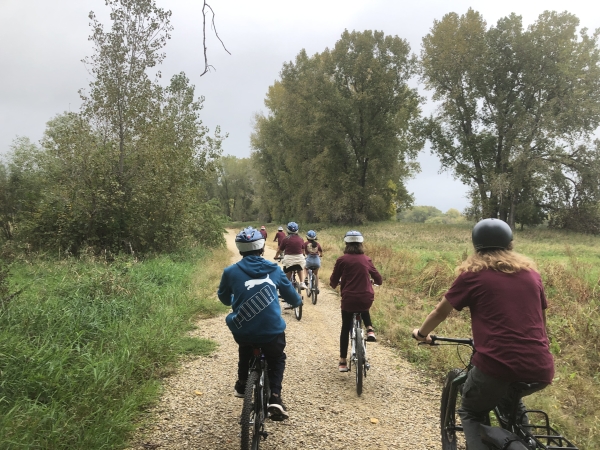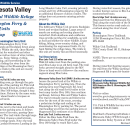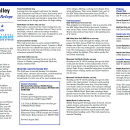
Biking is a great way to experience the refuge. Nearly 50 miles of trail are available along the river, in the prairie bluffs, and through the floodplain forest. Trails are open to biking year-round and electric-assist bicycles are welcome.
Refuge trails are mixed use; please practice trail etiquette and be aware of other visitors using the trails. Cyclists must yield to all other trail users.
Refuge trails and service roads are open to bicycling, with the following exceptions:
- Bluff Trail, from Indian Mounds spur to Old Cedar Avenue: CLOSED to bicycling
- Hillside Trail, located at the Bloomington Education and Visitor Center grounds: CLOSED to bicycling
- Bicycles are not allowed off established trails at any time. Fat bikes must remain on established trails, even during winter months
- Please respect the land and refrain from biking after a flood or rain event to prevent erosion and maintain the trail surface.
Be Prepared
- Trails and service roads may be paved, crushed gravel, or hard-packed dirt. Some of the less developed roads may have areas of loose sand
- Be aware of the possibility of vehicles on the roads. Refuge staff, researchers, and utility services can be encountered on service roads and trails
- If you encounter deep mud or pooling water, dismount and carefully pass in the immediate shoulder of the trail or service road. It is against Federal regulations to bicycle off trail, or create new trails and temporary bridge structures
- Report any downed trees, or other trail maintenance issues by calling 952-854-5900
Trail Etiquette
- Heavy rains can create wet and muddy trail conditions. Minimize trail ruts by dismounting bicycles or riding on a drier day. If you must use a wet or muddy trail, ride through it instead of around to avoid widening the trail corridor. Leave trails in the same or better condition than you found them.
- Know your right-of-way. Cyclists yield to all other trail users. If you encounter another cyclist, yield to the rider moving uphill.
- Mind trail closures to avoid putting yourself or others at risk. Trail users have been injured or needed rescue from floodwaters after using a closed trail.
- Winter trail etiquette:
- Some trails are groomed for skiing and bicycling in the winter. Let groomed trails set up for a few hours before using them.
- Adjust your bike tire pressure down to increase floatation on snow, and minimize rutting of snowy trail surfaces.
- Cyclists should yield to foot travel (hiking, skiing, and snowshoeing).
- Riding off trail is always prohibited, even in winter.
Refuge trails intersect and connect with many other local trail systems and reviewing their maps can aid in trip planning:
- Minnesota Valley State Trail
- Big Rivers Regional Trail
- Fort Snelling State Park
- Nokomis-Minnesota River Regional Trail
- Nine Mile Creek Regional Trail
Our Partners
Minnesota Off-Road Cyclists (MORC) is a non-profit volunteer organization dedicated to safeguarding the future of mountain biking in Minnesota through the promotion of responsible riding, establishment and maintenance of mountain biking trails, and preservation of Minnesota's natural resources. MORC’s mission is ‘Gaining and Maintaining Trails’. They partner with area land managers, including the wildlife refuge, to help enhance the sport of mountain biking in the Minneapolis/St. Paul metro area. MORC currently manages trail maintenance on the refuge & City of Bloomington’s River Bottoms trail, which is enjoyed by thousands of riders each month.
Bloomington Off-Road Cycling Alliance (BORCA) advocates for, develops, builds, and maintains environmentally sustainable, non-motorized singletrack trails and bike parks for all riders and all abilities. Their values are based on 4 principles of responsible riding: respect the trails, respect other users, respect animals and environment, and ride in control and to your ability. BORCA works with the wildlife refuge to provide public cycling programs and trail maintenance in the Bloomington area. Together, BORCA and the refuge are working to get more people on bikes.
Deep Woods Trail Groomers makes biking accessible during the winter. Volunteers from Deep Woods lay a 22-inch track after >1 inch snowfall. Winter trail grooming occurs on the Long Meadow Lake Trail between the American Boulevard Trailhead and Lyndale Landing, and on the River Bottoms trail between Lyndale Landing and Bloomington Ferry. Grooming increases trail accessibility in the winter by packing the snow down and creating a smooth surface that will freeze overnight, allowing hikers, bikers, and other trail users more winter trail usage.






